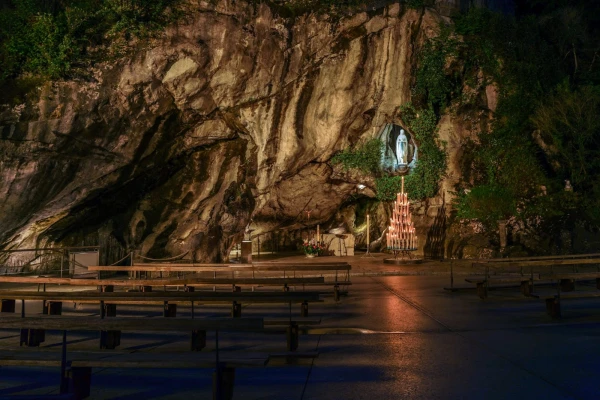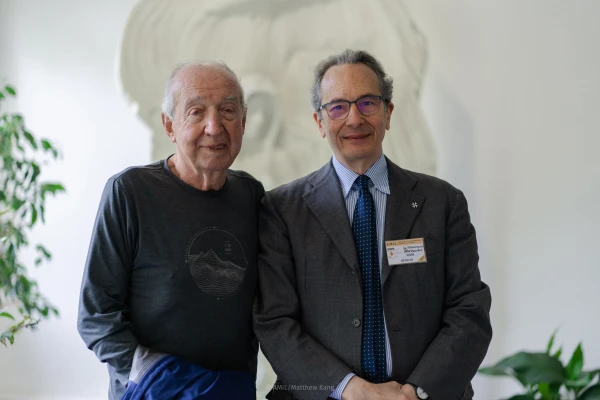St. Louis, Mo., Feb 11, 2023 / 04:00 am
In April 1962, a 23-year-old Italian soldier named Vittorio Micheli was diagnosed with a malignant tumor in his left hip.
“[The] tumor had already destroyed part of my pelvis and was attacking the femoral head. And so I had very little time left to live,” Micheli, now 82, told CNA.
After oncologists at a hospital in northern Italy threw up their hands, Micheli’s mother started to pressure Micheli’s brother, a priest, to take him to Lourdes. The magnificent shrine in southern France marks the site where a young St. Bernadette Soubirous witnessed apparitions of Mary beginning on Feb. 11, 1858. The spring of water at the shrine is said to have miraculous properties, attracting millions of people every year seeking physical and spiritual healing.
Against the advice of his doctors, Micheli obtained permission from the military to make the trip.
“I did all the services, processions, Stations of the Cross, [bathed in] the pools… it’s not like I noticed anything,” Micheli said.
“Only [after] going back I felt that something had changed. First of all, I no longer needed pain relievers. And then I started eating again. Before, I didn’t eat anymore. And there was this sense of well-being, of tranquility.”
“Back in the military hospital, no one paid any attention. I, however, started to get out of bed, started to walk, still with a cast and crutches. They finally decided to take X-rays and saw that the tumor was gone… they did more tests, doctors from outside also came… they sent me home. In short, [I was] cured.”
Ultimately, Micheli’s 1963 cancer cure would go down in history as the 63rd officially recognized miraculous healing at Lourdes, declared as such by Micheli’s archbishop in 1976 after more than a dozen years of medical investigation.

Now, 60 years on from his cure, Micheli still returns to the site where it happened. For years, the Italian would stay for 10-15 days a year to volunteer as a “brancardier,” or stretcher-bearer, for sick people seeking similar miraculous cures. During his work as a brancardier, Micheli met the woman who would become his wife.
Speaking to CNA in May 2022 during an annual military pilgrimage, Micheli said he does not know “why [he] was chosen” to be healed out of the thousands who come to Lourdes every year — likely not because of his own merit, he admitted, but “maybe the merit of my mother,” who had strongly encouraged him to seek healing at Lourdes.
The now octogenarian Micheli remains grateful for the miracle that saved his life six decades ago and said he considers himself to have a “usual” life, practicing his faith as a Catholic as best he can.
“I think life is like a ladder you do one step at a time. You never know if and how you’ll get there. I try to be a good Christian — however, I don’t know if I am,” Micheli said.
‘Deep study’
Throughout the years, at least 7,000 people have reported experiencing supernatural healings at Lourdes, but a mere 70 of those cures have been recognized by the Catholic Church as miraculous — the latest, which took place in 2008, was declared in 2018.
Alessandro de Franciscis, president of the Lourdes Office of Medical Observations, is charged with investigating each claim of a miraculous cure — a task he does not take lightly. The local bishop of the Diocese of Tarbes and Lourdes appointed de Franciscis to his role in 2009.
(Story continues below)
“We scrutinize and study an alleged cure with very deep engagement and with very strict criteria,” the Italian medical doctor told CNA.
“This is the only religious institution — not in the Catholic world, in all religions put together — in which there is such a precise and thorough, deep study of the alleged cure.”

The Office of Medical Observations was created in 1883 to study all the alleged cures that were being reported at Lourdes. The criteria for the investigation of an alleged miraculous cure are numerous, and involve the investigation of whether the ailment was medically diagnosed with a severe prognosis, and whether the cure was instantaneous, lasting, and unexplainable by normal scientific means.
The rigor of the scientific investigative process is borne out by the fact that out of the thousands of alleged cures de Franciscis and his team have personally investigated, just three have been declared miraculous during his tenure.
De Franciscis, a practicing Catholic, said the healings at Lourdes have a way of capturing the imaginations of people of all faith backgrounds, just as the healings that Jesus himself did in the Gospels drew people to him and demonstrated his power.
“The one thing I learned in these 13 years of residency in Lourdes is that sometimes you have to lift up your hands and say, ‘This I do not understand,’” de Franciscis said.
“In the world, in our experience of faith, you cannot explain everything rationally. And there are things we cannot explain that are part of the treasure of our faith. I think that in the pilgrimage, to Lourdes as in any other place of pilgrimage, and in the cures of Lourdes, there is a strong evangelizing meaning.”
De Franciscis first came to Lourdes as a teenager to volunteer in the same role that the now-healed Micheli performs to this day, as a brancardier, or stretcher-bearer. His experience serving the sick and the handicapped at Lourdes helped to inspire him to become a physician.
“As a young volunteer in Lourdes, I was part of those who found that there was an injustice, why a few were cured, and so many others not,” de Franciscis admitted.
“The cured persons of Lourdes that I have met, instead told me the opposite. They would say, ‘Why me and not someone else?’ So it is very clear that each of us lives [our] own Christian path in a different way … Everyone leaves from Lourdes, not necessarily physically cured, but certainly with new hope and new strength in their hearts,” the doctor said.







